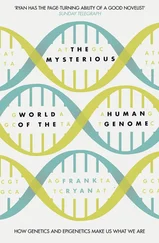Gary Marcus - Kluge - The Haphazard Construction of the Human Mind (Houghton Mifflin; 2008)
Здесь есть возможность читать онлайн «Gary Marcus - Kluge - The Haphazard Construction of the Human Mind (Houghton Mifflin; 2008)» весь текст электронной книги совершенно бесплатно (целиком полную версию без сокращений). В некоторых случаях можно слушать аудио, скачать через торрент в формате fb2 и присутствует краткое содержание. Жанр: Старинная литература, на английском языке. Описание произведения, (предисловие) а так же отзывы посетителей доступны на портале библиотеки ЛибКат.
- Название:Kluge: The Haphazard Construction of the Human Mind (Houghton Mifflin; 2008)
- Автор:
- Жанр:
- Год:неизвестен
- ISBN:нет данных
- Рейтинг книги:3 / 5. Голосов: 1
-
Избранное:Добавить в избранное
- Отзывы:
-
Ваша оценка:
- 60
- 1
- 2
- 3
- 4
- 5
Kluge: The Haphazard Construction of the Human Mind (Houghton Mifflin; 2008): краткое содержание, описание и аннотация
Предлагаем к чтению аннотацию, описание, краткое содержание или предисловие (зависит от того, что написал сам автор книги «Kluge: The Haphazard Construction of the Human Mind (Houghton Mifflin; 2008)»). Если вы не нашли необходимую информацию о книге — напишите в комментариях, мы постараемся отыскать её.
Kluge: The Haphazard Construction of the Human Mind (Houghton Mifflin; 2008) — читать онлайн бесплатно полную книгу (весь текст) целиком
Ниже представлен текст книги, разбитый по страницам. Система сохранения места последней прочитанной страницы, позволяет с удобством читать онлайн бесплатно книгу «Kluge: The Haphazard Construction of the Human Mind (Houghton Mifflin; 2008)», без необходимости каждый раз заново искать на чём Вы остановились. Поставьте закладку, и сможете в любой момент перейти на страницу, на которой закончили чтение.
Интервал:
Закладка:
115 Book on physics: Smolin, 2006.
116 Chomsky and colleagues: Hauser et al., 2002. Pinker and Jackendoff: Pinker 8c Jackendoff, 2005. Chimpanzee language is missing more than just recursion: Premack, 2004. The trouble with trees: Marcus 8c Wagers, under review.
117 Troubles with center embedding: Miller 8c Chomsky, 1963.
Types of recursion: Parker, 2006.
118 Problem with trees: Parker, 2006.
120 Study of ambiguity: Keysar, 2002.
121 "Good enough" language: Ferreira et al, 2002.
Animals on the ark: Reder 8c Kusbit, 1991. More people have been to Russia than I have: Montalbetti, 1984.
6. PLEASURE
124 237 reasons to have sex: Meston 8c Buss, 2007.
Automatic classification into good and bad: Fazio, 1986.
125 The more we need 'em, the more we like 'em: Fishbach et al., 2004.
Leisure time: U.S. Department of Labor Statistics, 2007.
126 Television watching: Kahneman et al, 2004; Nielsen, 2006.
127 Reaching for the whiskey bottle: Cheever, 1990.
Primrose path: Herrnstein 8c Prelac, 1992.
132 Video game design: Thompson, 2007.
133 Lullaby hypothesis: Trehub, 2003.
Music and sexual selection: Miller, 2000.
Problems with theories of music evolution: Fitch, 2005.
134 Apes that beat their chests rhythmically: Fitch, 2005. Goldfish and pigeons trained to distinguish musical styles: Fitch, 2005.
184 Notes to Pages 137-147
137 Coping ability in victims of accidents: Brickman et al, 1978; Linley & Joseph, 2004.
138 The relation between wealth and happiness: Kahneman et al., 2006. Happiness in Japan, 1958 to 1987: Easterlin, 1995. Happiness in the United States: Easterlin, 1995. Happiness and money: Layard, 2005. Relative income: Frank, 2001. The happiness (hedonic) treadmill: Brickman & Campbell, 1971.
139 Dates: Strack et al, 1988.
Marriages: Schwarz, 1991.
Health: Smith et al., 2006.
The more we think about how happy we are: Ariely et al., 2006.
Rumination: Lyubomirsky et al., 1998.
141 Smarter, fairer, more considerate, more dependable, more creative: Alicke et al., 1995; Brown, 1986; Dunning et al., 1989; Messick et al., 1985. Better drivers: Svenson, 1981. Better than average health: Kirscht et al., 1966. Cognitive dissonance: Festinger 8c Carlsmith, 1959.
142 Serotonin evolution: Allman, 1999.
Emotions across species: Ledoux, 1996.
143 Souped-up anterior cingulate: Allman et al., 2002. Anterior cingulate and conflict between cognitive systems: McClure et al., in press. Teenagers: Galvan et al., 2006. Evolutionary old before new: Finlay & Darlington, 1995.
7. THINGS FALL APART
145 Eskimo words for snow: Pullum, 1991.
Neural noisiness: Montague, 2006.
Junk food and cognitive load: Shiv & Fedorikhin, 1999.
146 Deliberative systems left behind: Ferreira et al, 2006.
Stereotyping and cognitive load: Sherman, 2000.
Egocentrism and cognitive load: Epley et al, 2004.
Anchoring and cognitive load: Epley 8c Gilovich, 2006.
147 Daydreaming about sex: Howard, 2004.
Zoning out: Schooler et al., 2004.
Recent NHTSA study. http://www.nhtsa.dot.gov/staticfiles/DOT/NHTSA/
NRD/Multimedia/PDFs/Crash%2oAvoidance/20o6/DriverInattention
.pdf.
Leading causes of death: Minino et al., 2002.
148 Costs of procrastination: Steel, 2007.
The "quintessential self-regulatory failure": Steel, 2007.
149 Lifetime prevalence of disorders: Kessler et al., 2005.
151 Vonnegut, tribes, and extended families: National Public Radio interview, January 23, 2006, http://www.npr.org/templates/story/story
.php?storyId=5165342. Virtually every trait depends on a mix of factors, some environmental, some biological: Marcus, 2004; Plomin, 1997. Shamans and schizophrenia: Polimeni 8c Reiss, 2002. Agoraphobia: Nesse, 1997. Anxiety: Marks 8c Nesse, 1997. Depression: Price et al, 1997 Schizophrenia incidence: Goldner et al., 2002.
152 Malaria: Nesse 8c Williams, 1994.
Sociopathy: Mealey, 1995.
155 Cost-benefit and orbitofrontal damage: Bechara et al., 2000.
157 Depressive realism: Alloy 8c Abramson, 1979; Pacini, 1998.
Mood-congruent memory: Watkins et al., 1996. 160 Most mental disorders have a genetic component: Plomin et al., 2001.
8. TRUE WISDOM
162 Imperfections of the mind rarely discussed: For three notable exceptions, see Clark, 1987; Linden, 2007; and Stitch (in press).
163 The Beak of the Finch: Weiner, 1994. Recently completed genomes: http://www.ensembl.org/index.html;
Gregory, 2005.
165 Listing alternatives: Hoch, 1985; Koriat et al, 1980. Consider the opposite: Arkes, 1991; Larrick, 2004; Mussweiler et al., 2000. Counterfactual thinking: Galinsky 8c Moskowitz, 2000; Kray et al., 2006.
167 Sample size education: Nisbett et al., 1983.
i86 Notes to Pages 168-176
168 Precommitment: Lynch & Zauberman, 2006.
Specific contingency plans: Gollwitzer 8c Sheeran, 2006. 169 Fruit salad versus cake, under cognitive load: Shiv 8c Fedorikhin, 1999. 170 Accountability: Tetlock, 1985.
Eyes and the honor system: Bateson et al., 2006. Distance and decision making: Liberman et al., 2002; Lynch 8c Zauberman, 2006.
171 Irrationality dissipating with time: Koehler, 1994.
Time to steep: Dijksterhuis 8c Nordgren, 2006.
Anecdotal data, against better judgment: Wilson 8c Brekke, 1994.
Psychological cost of decisions: Schwartz 8c Schwartz, 2004.
Physical cost of decisions: Gailliot et al., 2007.
172 Mortality salience and the effects of being told to "be rational": Simon et al., 1997. See also Epstein et al, 1992. Further evidence that admonitions to be rational might work: Ferreira et al, 2006.
173 Education for Thinking: Kuhn, 2005. Graduating without much competence as a thinker: Nickerson, 1988.
174 Taking the Internet at face value: Metzger et al., 2003. With little regard as to the accuracy: Graham 8c Metaxas, 2003. Credibility and visual design: Fogg et al, 2002. Unsophisticated evaluations of social and political issues: Perkins, 1985.
175 Facts, opinions, and evaluating competing evidence: Kuhn 8c Franklin, 2006. History of understanding the brain: Zimmer, 2004. The teachability of critical thinking skills: Solon, 2003; Williams et al., 2002; Moseley et al, 2004. Philosophy for children: Topping 8c Tricky, 2007. Harry Stottlemeiers Discovery: Lipman, 1970/1982.
176 Knowing about knowing: Metcalfe 8c Shimamura, 1994.
REFERENCES
Ainslie, G. (2001). Breakdown of will. Cambridge, UK: Cambridge University Press.
Aizcorbe, A. M., Kennickell, A. B., & Moore, K. B. (2003). Recent changes in
U.S. family finances: Evidence from the 1998 and 2001 Survey of Con
sumer Finances. Federal Reserve Bulletin, 89(1), 1-32. Alicke, M. D., Klotz, M. L., Breitenbecher, D. L., Yurak, T. J., & Vredenburg,
D. S. (1995). Personal contact, individuation, and the better-than-average effect. Journal of Personality and Social Psychology, 68(5), 804-25.
Allais, M. (1953). Le comportment de l'homme rationnel devant le risque: Critique des postulats et axiomes de l'יcole amיricaine. Econometrica, 21, 503-46.
Allman, J. (1999). Evolving brains. New York: Scientific American Library. Distributed by W. H. Freeman.
Allman, J., Hakeem, A., & Watson, K. (2002). Two phylogenetic specializations in the human brain. Neuroscientist, 8(4), 335-46.
Alloy, L. B., & Abramson, L. Y. (1979). Judgment of contingency in depressed and nondepressed students: Sadder but wiser? Journal of Experimental Psychology, 108(4), 441-85.
Читать дальшеИнтервал:
Закладка:
Похожие книги на «Kluge: The Haphazard Construction of the Human Mind (Houghton Mifflin; 2008)»
Представляем Вашему вниманию похожие книги на «Kluge: The Haphazard Construction of the Human Mind (Houghton Mifflin; 2008)» списком для выбора. Мы отобрали схожую по названию и смыслу литературу в надежде предоставить читателям больше вариантов отыскать новые, интересные, ещё непрочитанные произведения.
Обсуждение, отзывы о книге «Kluge: The Haphazard Construction of the Human Mind (Houghton Mifflin; 2008)» и просто собственные мнения читателей. Оставьте ваши комментарии, напишите, что Вы думаете о произведении, его смысле или главных героях. Укажите что конкретно понравилось, а что нет, и почему Вы так считаете.












